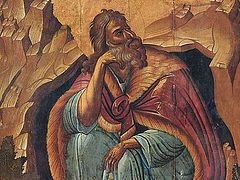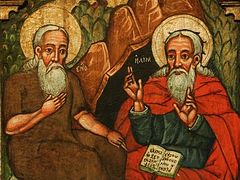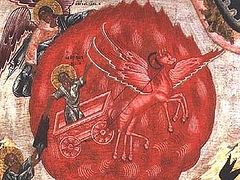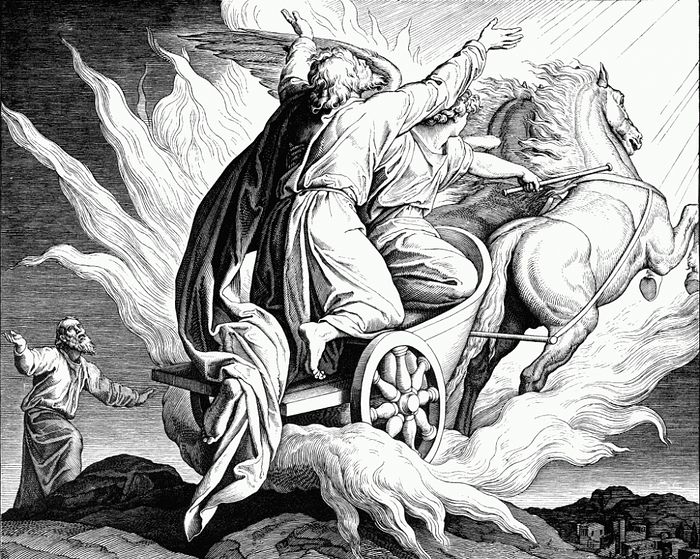 St. Elias Ascending to Heaven in a Chariot of Fire. By Julius Schnorr von Carolsfeld
St. Elias Ascending to Heaven in a Chariot of Fire. By Julius Schnorr von Carolsfeld
How did a Hebrew man, who was born about 3,000 years ago in the town of Tishbe of the historical Gilead region of ancient Israel, become a great prophet of God, and how was he deemed worthy of being lifted to heaven in a fiery chariot? Can we become like him?
In truth, it often seems that saints who stare at us from marvelous ancient icons are far away from us and are separated from us by the boundary between the sinful earth (where we live) and the Heavenly Kingdom (where they dwell) or by thousands of years. Sometimes it also seems that they are mere characters from fairy-tales and myths or the embodiment of the unattainable Christian ideal.
But in reality they were human beings like us—they were made of flesh and blood. They were sick and sad, happy and cheerful; they suffered and wept, grieved and struggled. They were no different from us. God gave both saints and us the same body and soul. True, each saint bore the stamp of his time in his habits, character, way of life and mentality; yet the same spiritual warfare has been in the souls and hearts of saints and us sinners alike—an ongoing battle between good and evil in which every human being chooses either to be like Christ or to be like the demons. Our lives are always directed either towards Paradise or towards hell—there can be no other alternative.
Once a disciple asked an Athonite father: “Is it possible to attain the Kingdom of Heaven?” And he answered: “It is virtually impossible, but it is worth trying!”
Guided by this motto, let us imagine that we are at a lesson and its theme is “the holy Prophet Elias.” And we have been given two problems to solve. Firstly, “How did a Hebrew man, who was born about 3,000 years ago in the town of Tishbe of the historical Gilead region of ancient Israel, become a great prophet of God, and how was he deemed worthy of being lifted to heaven in a fiery chariot?” And, secondly, “Can we become like him?”
The Savior through the Apostle Peter set the following goal for us: But ye are a chosen generation, a royal priesthood, an holy nation, a peculiar people; that ye should shew forth the praises of Him Who hath called you out of darkness into His marvellous light; Which in time past were not a people, but are now the people of God: which had not obtained mercy, but now have obtained mercy (1 Pet. 2:9-10). And, through the Apostle Paul, we have a word on all the saints of the past: And these all, having obtained a good report through faith, received not the promise: God having provided some better thing for us, that they without us should not be made perfect (Heb. 19:39-40).
This call is addressed to all of us. Let us attain perfection using the “arsenal of instruments” that the Orthodox Church provides us with. Let us learn from the Lives of saints—for example, of the holy Prophet Elias.
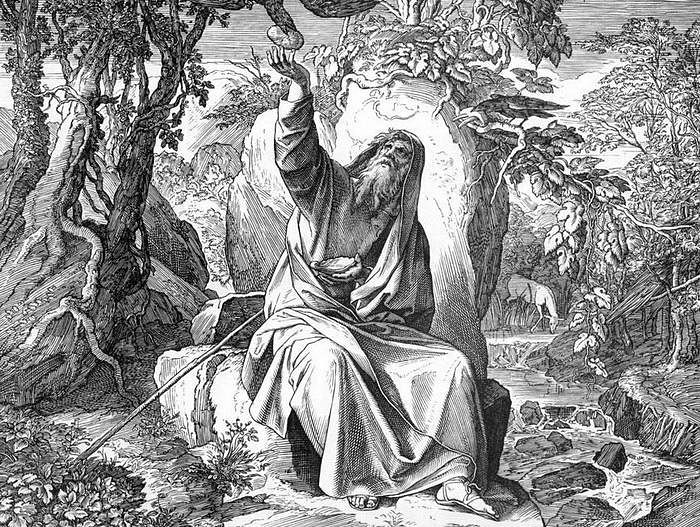 Ravens Feed Elias. By Julius Schnorr von Carolsfeld
Ravens Feed Elias. By Julius Schnorr von Carolsfeld
Lesson 1: Gluttony and the miseries associated with it
With the help of God the Hebrews defeated the Canaanites. They entered the Promised Land that was flowing with milk and honey. Bunches of grape there were so juicy and heavy that several men had to carry one of them on a pole. The reigns of the holy Prophet and King David and his son Solomon (from the early eleventh till the mid-tenth century B.C.) marked the golden age of Jewish religion, state, culture and economy. Towards the end of King Solomon’s rule, material prosperity began to have a negative impact on the Hebrews—it engrossed their attention. Overindulgence in food and “belly worship” result in hardness of heart. Amid feasts, money and self-indulgence Hebrews no longer wanted to lift up their eyes to the true God but began to look down towards earth. And then they found the cults of the Canaanite gods (that would gratify their passions) very attractive—notably, the cult of Baal of which we will talk below. And the Hebrews under King Solomon gave themselves over to pagan sensual pleasures, abandoning the true God, Who had guided them through the wilderness and protected them affectionately like a loving Father.
This pagan idol-worship resulted in hedonism, individualism, egoism, self-love and, therefore, dislike for and animosity towards their neighbors and brothers.
Under King Rehoboam (ruled 928—911 B.C.), Solomon’s son, an internecine war began among the Hebrews. Their kingdom was split into Judah and Israel (c. 928 B.C.).
While the true faith was still preserved in Judah, the faith in Israel blended with paganism and ceased to be a divinely-inspired faith.
The activity of the holy Prophet Elias (ninth century B.C.) concurred with the reign of the impious King Ahab of Israel, who committed an act that contradicted the religious law of the Hebrews, received by them from the Torah of Moses. Ahab married a pagan Philistine woman named Jezebel (the Philistines were very hostile to the Hebrews), who was a zealous priestess of Baal and introduced the worship of Baal all over Israel, establishing this cult as an official state religion.
And at that very time the Lord sent His great prophet, Elias the Tishbite, to the Israelites.
That is the end of lesson 1 for us. What conclusion can we, Orthodox Christians of the twenty-first century, draw from it?
We often complain that our money is tight. But, at the same time, we have an abundance of huge supermarkets, with their numerous beautiful store windows, offering customers a wide range of sausages, drinks and cakes. We have plenty of computers, iPads, tablets and all types of “smart” devices that make our everyday lives easier and more comfortable. In addition, there is modern pop culture, which encourages people to serve sensual pleasures—the idols of our age. Today, if the battery of someone’s cellphone discharges, he panics at the thought of spending a day without his gadget! If electricity is suddenly cut off or if there is no internet connection for an hour, we think that life has stopped! Haven’t we already turned into inveterate, self-indulgent hedonists?
And what will we do when at some point we will have to choose between St. Elias (emaciated, worn out with suffering, in rags and a hairshirt) and the well-fed Jezebel, who lives in clover? Will we find strength with the help of God to humble our dear selves and withdraw to the wilderness, to the ascetic life and God? This is the Hamletian question of our time!
The satiated stomach begets depravity of mind. Egoism gives rise to hatred for our brothers. What way out does the holy Prophet Elias suggests to us?
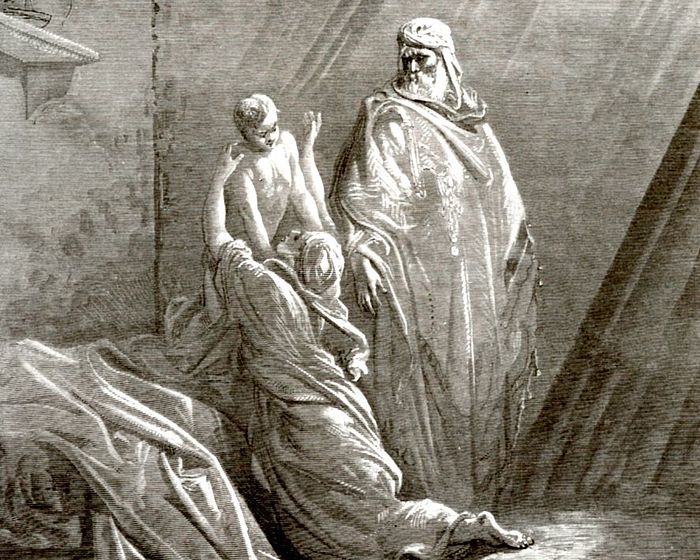 St. Elias Raises the Son of the Widow of Zarephath. By Paul Gustave Dore.
St. Elias Raises the Son of the Widow of Zarephath. By Paul Gustave Dore.
Lesson 2: Self control
In the Philokalia, St. Mark the Ascetic says: “Without contrition of the heart, it is altogether impossible to rid ourselves of evil. Now the heart is made contrite by threefold self-control: in sleep, in food and in bodily relaxation1.”
Every Orthodox Christian has only one enemy—his own ego, his old Adam, for whom his passions, pleasures, sins and vices have become his second nature. This is whom we should struggle with. Let us recall the words of the Apostle Paul: And they that are Christ’s have crucified the flesh with the affections and lusts (Gal. 5:24). This is the essence of the podvig [ascetic labor, exploit in Russian.—Trans.] of all the saints who shone forth from ancient times till our days.
Life as bloodless martyrdom. This is the essence of the holy Prophet Elias’ ascetic labor.
In prophecies, the holy Prophet and Forerunner John the Baptist is often compared with St. Elias. In the book of the Prophet Malachi, St. John is openly called “Elias”: Behold, I will send you Elijah the prophet before the coming of the great and dreadful day of the Lord: And he shall turn the heart of the fathers to the children, and the heart of the children to their fathers, lest I come and smite the earth with a curse (Mal. 4:5-6).
Our Lord Jesus Christ too witnessed that John the Baptist was called “Elias”: But I say unto you, That Elias is come already, and they knew him not, but have done unto him whatsoever they listed (Mt. 17:12). Indeed the lives, characters, exploits and services of Sts. John the Baptist and the Prophet Elias are remarkably similar.
The Prophet Elias was in essence the first monk and the first dedicated to virginity in the Old Testament. A great faster, he walked barefoot, wore a rough mantle of camel’s hair, which was very coarse, uncomfortable, irritated the skin and resembled a hairshirt worn by Christian ascetics. He wore a leather girdle around his waist (like Orthodox monks) and carried a staff in his hand (like bishops) as a symbol of his special spiritual authority.
His name (“Eliyahu” in Hebrew) means “God’s fortress” or “my God is Yahweh.” The word “Yahweh” (“Jehovah”) means “The Existing One.” God revealed this name of His to the Prophet Moses when He spoke to him through the Burning Bush.
It was very dangerous to bear such a name in the time of Ahab and Jezebel. The true faith was prohibited in their state. According to one version, the holy prophet’s birth name was different, but in the period of raging paganism and persecution of the true faith the saint changed his name to Elias—something that was most probably punishable by death in the Kingdom of Israel. “My God is Yahweh, the true God of the Hebrews.” Elias bore his name like a banner. He was ready to endure torments and accept death. And with that shining banner he entered the darkness of paganism in order to enlighten the nation that was drowning in iniquity.
Lesson 2 from the Life of the Prophet Elias teaches us sensible abstinence, by which we restrain our bodies just as we restrain a blinded and skittish horse that rushes towards the edge of the precipice.
Let us recall the Savior’s words: Howbeit this kind goeth not out but by prayer and fasting (Mt. 17:21). He said this about demons.
Sensible prayer and fasting will drive away demons from us and invite the grace of the Holy Spirit into the temples of our hearts.
Likewise, our hearts should be rooted and grounded on the following motto: “My God is Yahweh”, and according to the New Testament tradition: “My God is the Father, the Son, and the Holy Spirit.” The strong Orthodox faith and sensible abstinence are the foundation and beginning of life. Then with the help of God our deeds will be aimed in the right direction. And here we, dear brothers and sisters, proceed to lesson 3.
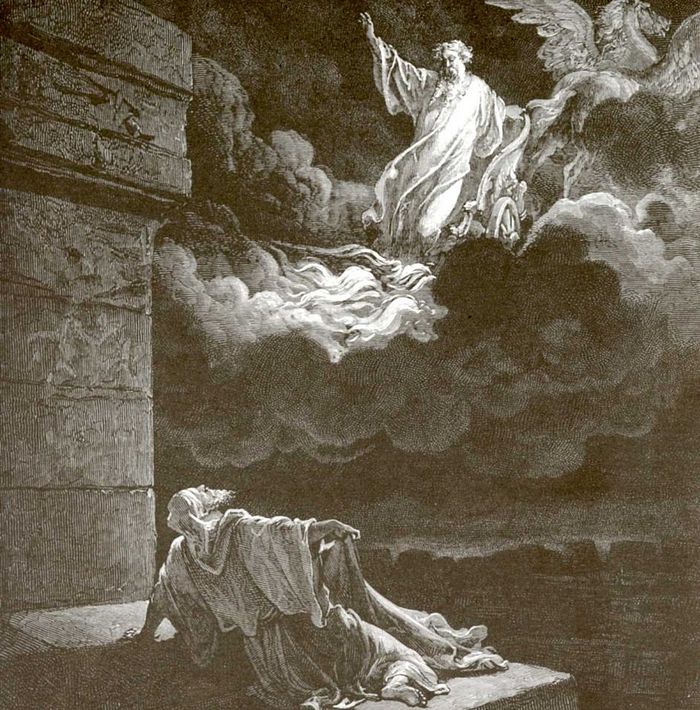 The Prophet Elias in the Chariot of Fire. From Paul Gustave Dore’s Bible illustrations
The Prophet Elias in the Chariot of Fire. From Paul Gustave Dore’s Bible illustrations
Lesson 3: Works of mercy
Disasters and cataclysms befell the Israelites and the neighboring peoples for the sins they had committed. The heaven was shut up for three years, causing drought and famine. The spiritual desert in the people’s hearts and souls brought forth a real desert on earth in this physical realm. We see a striking connection between human souls and nature.
But there were still some people who were able to feel the truth of God and do God’s work. The Savior said: But I tell you of a truth, many widows were in Israel in the days of Elias, when the heaven was shut up three years and six months, when great famine was throughout all the land; But unto none of them was Elias sent, save unto Sarepta, a city of Sidon, unto a woman that was a widow (Lk. 4:25-26).
The Lord saw a very merciful and loving heart in that woman (who was most probably from Canaan and a gentile) of Zarephath (Sarepta)—a Phoenician city on the Mediterranean coast between Sidon and Tyre. That is why Elias was sent to her (he didn’t come to her of his own accord). First the holy prophet tested her. He asked the widow to give him a morsel of bread and she immediately shared the last bits of food (intended for herself and her children) with him.
Let us look deeper into that woman’s heart; she realized that these were the last bits of her flour and oil and that she and her children would die of hunger without them. Nevertheless, she found the strength to feed the destitute stranger, offering him two “last mites”. And for that the Lord through His prophet blessed her with His grace in abundance. Through St. Elias’ prayers the flour and oil in the widow’s house thenceforth never ran out. They survived the terrible famine. More than that, some time later St. Elias brought the son of the widow of Zarephath back to life.
And here is lesson 3 for all of us to learn: A loving and merciful heart that pours out its love by good works onto its neighbors and everybody else, invites the grace of God and is revived in Christ—something that is true at all times.
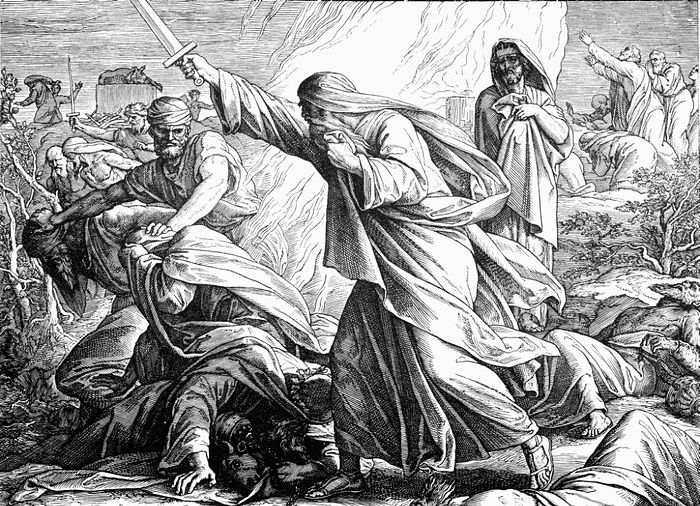 St. Elias Slaughters the Prophets of Baal. Engraving by Julius Schnorr von Carolsfeld.
St. Elias Slaughters the Prophets of Baal. Engraving by Julius Schnorr von Carolsfeld.
Lesson 4: The Lord always knows what He does, and He turns all things that happen to us for our good
Thus the official religion of the Kingdom of Israel in the ninth century B.C. was the cult of Baal. Confessors of the faith in the true God were persecuted.
The word “baal” has Semitic roots and means “lord”, “owner”. Pagans of Canaan, Phoenicia and Syria worshipped this idol. At different places and times Baal was considered a god of the sun, fertility, water and thunderstorm. His cult was centered in the Phoenician Mediterranean city of Tyre. Because of Jezebel, this religion was spread all over the Kingdom of Israel as well. The worship of Baal involved a lot of cruelty and sexual immorality. Since Baal was believed to be a fertility deity who gave birth to the universe, religious rites associated with him were based on orgies and voluptuousness. During those rituals, heathen priests would cut their wrists or hands in ecstasy.
According to the Old Testament, that cult, among other things, consisted of human sacrifices. Heathens offered their own children to Baal by burning them in fire. The book of the Prophet Jeremiah reads: Thus saith the Lord of hosts, the God of Israel; Behold, I will bring evil upon this place… Because they have forsaken Me, and have estranged this place, and have burned incense in it unto other gods, whom neither they nor their fathers have known, nor the kings of Judah, and have filled this place with the blood of innocents; They have built also the high places of Baal, to burn their sons with fire for burnt offerings unto Baal, which I commanded not, nor spake it, neither came it into My mind (Jer. 19:3-5).
Thus the Prophet Elias, with the help of God, fought against the atrocities that had been elevated to the level of the law of the land! But God is not mocked (Gal. 6:7).
Nevertheless, in his heart of hearts King Ahab had the fear of God. Like Herod, who had an impious wife but held St. John the Baptist in great reverence, Ahab venerated the holy Prophet Elias. Totally befuddled and disorientated, the king and his people didn’t know the truth, but they wanted to find it. By a royal decree a religious contest between St. Elias and the prophets of Baal was organized. Two altars were built and installed—one for the true God of the Hebrews, and one for Baal. And they agreed that the god who would send fire from heaven to burn the sacrifice on his altar was the true God. All Israelites gathered on Mount Carmel to see which religion was the true one. And the all-merciful Lord again had compassion on His poor people who had been lost and misled. Of course, despite the efforts of the prophets of Baal to call down fire from heaven, their prayers remained unanswered.
St. Elias had the unconditional, ardent, pure faith of a child! He ordered that four jars of water be poured all over his altar and offering, and thus the trench around his altar was filled with water. Despite this, fire came down from heaven and consumed his sacrifice. The true faith triumphed in Israel! People believed this and turned to God.
It seems to us that the horrendous cult of Baal passed into oblivion long ago and has nothing to do with the present. But that is not true! Look, abortions have become a mass phenomenon in our country and across the globe. And an abortion is nothing but a legalized murder. Today fathers and mothers offer sacrifices to the idol of lust by killing their unborn children.
Is a society which legalizes such an awful phenomenon as abortions better than one that legalizes sacrifices to Baal? I think the former is no better than the latter.
But now let’s talk about a different thing. What was St. Elias’ sacrifice based on? It was an unconditional faith in his God—that He would come, help and save him.
And we should imitate St. Elias. Instead of giving way to despair in difficult situations we must understand that the Lord carries us in His arms as His little ones. And if we pray and invoke His name, He is sure to help us. No matter how much “water” sorrows, illnesses, miseries and calamities may “pour” onto the “altars” of our souls--heavenly fire will surely come down and give comfort to our souls if we pray to the Almighty and trust Him.
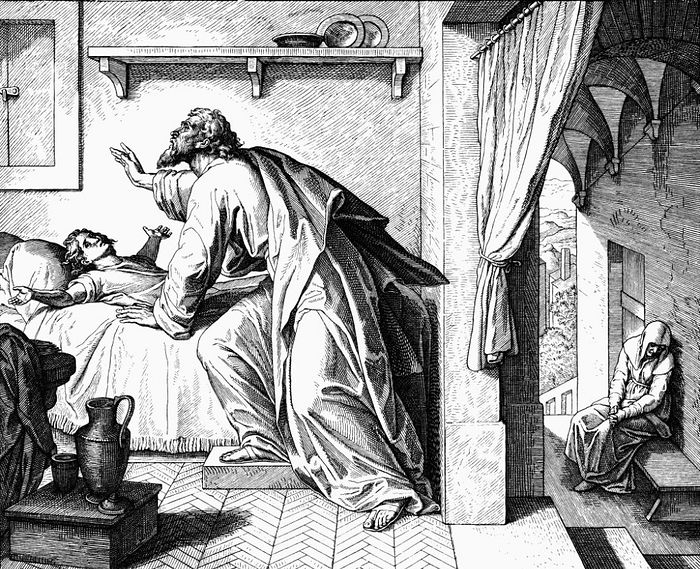 St. Elias Raises the Son of the Widow of Zarephath. By Julius Schnorr von Carolsfeld.
St. Elias Raises the Son of the Widow of Zarephath. By Julius Schnorr von Carolsfeld.
Lesson 5: Life is about struggling with sins to the end of our days, but there are joys and consolations from the Lord on this path
Following a resurgence of the true faith in the Kingdom of Israel, its people gradually reverted to paganism. Jezebel regained her power. In his homily for the feast of the Beheading of St. John the Baptist, St. John Chrysostom wrote: “Methinks there is no other beast on the earth like an evil woman.” Jezebel, a wicked woman, sought the slightest opportunity to destroy the holy prophet. St. Elias fled to Beersheba in the south of Israel. There, in deep despondency, he asked God to let him die. It seemed to him that the Israelites who wallowed in paganism had no chance to reform. He complained to God: I have been very jealous for the Lord God of hosts: because the children of Israel have forsaken Thy covenant, thrown down Thine altars, and slain Thy prophets with the sword; and I, even I only, am left; and they seek my life, to take it away (3 Kings 19:14).
But the Lord appeared to St. Elias in a gentle breeze and consoled the saint. God told him that Israel was not hopeless, that there were 7,000 Israelites who had never bent the knee to Baal, and that he (St. Elias) should go to them and bring them back to Him.
Hearing this, St. Elias took heart, returned to Israel and carried on his prophetic ministry.
This is something that often happens to us. We too fall under the weight of life circumstances, become dejected and grumble. We think that life has driven us into a corner, but it isn’t so. God appears to us in a gentle breeze amid trials and tribulations that humble our haughty and passionate souls. But he that shall endure unto the end, the same shall be saved (Mt. 24:13); My strength is made perfect in weakness (2 Cor. 12:9).
If only our souls wouldn’t become like Jezebel—hardened, embittered and cruel—after following sinful passions persistently.
Conclusion, or lesson 6: St. Elias’ chariot is prepared for us too
According to the Holy Scriptures and Tradition, the holy Prophet Elias is one of the three saints of the Church (the others are the Hebrew Patriarch Enoch and St. John the Evangelist) to be taken up into Heaven while still alive. And the body of the Most Holy Theotokos was also translated by Christ into heaven2 after Her repose.
All of this often seems absolutely unattainable to us. But we are wrong.
As St. Epiphanius of Cyprus wrote: “When Elias was born, his father Sobach saw in a vision angels of God around him. They swaddled him with fire and fed him with flames.”3
But we too were swaddled by angels when the sacrament of Baptism was being performed over us; and the grace of the Holy Spirit feeds us also with flames when we partake of the Body and Blood of Christ.
What is the Resurrection of Christ if not St. Elias’ fiery chariot that lifts us up to heaven, to Paradise?!
Our task is to walk towards it our entire lives, keeping God (as the center of our inner constitution) in our hearts. And each one of us should become another Elias in the etymological and spiritual senses. And the following words should be engraved on our hearts forever: “My God is the true God—the Holy Trinity.”
And sooner or later, the Jordan of life will part before the patient, loving and faithful soul, and you will be vouchsafed to have your own chariot of fire, drawn by a team of horses, which will bring you into the Heavenly Kingdom, the radiant and beautiful Heavenly Jerusalem!

